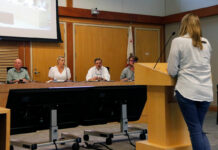The term “rain garden” is being used more and more by landscape architects and gardeners alike. It is a fanciful term that conjures images of a garden that magically creates rain. What a rain garden is, however, is one of many landscape features that fits into the category of “low impact development for storm water” or LID. Like many other LID features, rain gardens gather, hold, filter, and slow storm water runoff.
The basic principles of LID for storm water are to filter, infiltrate, and slow the flow of storm water. This is the “new school” way of thinking of storm water as opposed to the “old school” approach which was to design sites to move as much storm water as fast as possible off-site and into the storm drain system. Flood control and building foundation stability were the narrow focus. The problem with this old school, or traditional, method of managing storm water is that it can be detrimental to the health of our creeks and other waterways, including the Russian River. Storm water that flows off of hardscape, such as driveways, walkways and rooftops, typically carries pollutants with it into our storm drain system. The storm drain system then discharges storm water directly into our creeks and streams without being treated.
Another problem with directing storm water straight into the storm drain system is the effect of “hydromodification” of our streams. Hydromodification is the result of increased storm water runoff in terms of both volume and peak flow rate. The results are often eroded stream banks, downstream flooding, and increased sedimentation. These effects are harmful to fish and wildlife that depend on healthy and balanced waterways.
Fortunately, there are many options for reducing the effects of development with LID features. Rain gardens, just one example of LID, are sloped to gather rainwater from surrounding paved areas. They are underlain with soils and gravels that allow for slow percolation and then landscaped with plants that can tolerate saturated soils and even short periods of standing water while also keeping the soil in place, helping filter out some pollutants and slowing the flow of storm water.
Another LID feature that a homeowner can implement easily is to disconnect rooftop downspouts which drain directly onto hardscape and reroute the drainage to a vegetated area where roof runoff will be filtered and slowed before discharging into the storm drain system. Some of the runoff will infiltrate into site soils and be taken up by landscaping or natural vegetation. Homeowners should take precautions to not pose adverse effects to the structural integrity of foundations or steep hillside slopes.
The use of pervious or porous pavers for walkways, patios, parking areas and driveways is also an LID design option. Pervious pavers allow for infiltration of storm water into the soil through gaps intentionally left between paver bricks or stones. Porous pavers allow for storm water to infiltrate into the soil through holes or perforations in the pavers.
When we “slow the flow” of storm water, we protect stream banks from being eroded by an excessive volume of storm water hitting stream banks from storm drain systems. When we allow soils and plants to filter storm water, we reduce the amount of sediment and pollutants entering water ways. This in turn protects the fish and other aquatic life from pollutants. When we infiltrate more of our storm water, we replenish groundwater and allow a more natural water cycle to occur.
By building rain gardens and vegetated swales, installing permeable pavers and other LID features, we help protect the environment, especially our creeks and the Russian River. An excellent source of information for homeowners about LID is the guide “Slow it. Spread it. Sink it!” which was developed by the Sonoma Valley Groundwater Management Program. To download a copy of the guide, go to sscrcd.org/rainwater.php.
This article was authored by Cristina Goulart of the Town of Windsor on behalf of RRWA. RRWA (www.rrwatershed.org) is an association of local public agencies in the Russian River Watershed that have come together to coordinate regional programs for clean water, fisheries restoration, and watershed enhancement.








